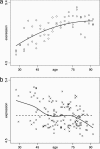Significance analysis of time course microarray experiments
- PMID: 16141318
- PMCID: PMC1201697
- DOI: 10.1073/pnas.0504609102
Significance analysis of time course microarray experiments
Abstract
Characterizing the genome-wide dynamic regulation of gene expression is important and will be of much interest in the future. However, there is currently no established method for identifying differentially expressed genes in a time course study. Here we propose a significance method for analyzing time course microarray studies that can be applied to the typical types of comparisons and sampling schemes. This method is applied to two studies on humans. In one study, genes are identified that show differential expression over time in response to in vivo endotoxin administration. By using our method, 7,409 genes are called significant at a 1% false-discovery rate level, whereas several existing approaches fail to identify any genes. In another study, 417 genes are identified at a 10% false-discovery rate level that show expression changing with age in the kidney cortex. Here it is also shown that as many as 47% of the genes change with age in a manner more complex than simple exponential growth or decay. The methodology proposed here has been implemented in the freely distributed and open-source edge software package.
Figures




References
Publication types
MeSH terms
Substances
Grants and funding
LinkOut - more resources
Full Text Sources
Other Literature Sources
Medical

